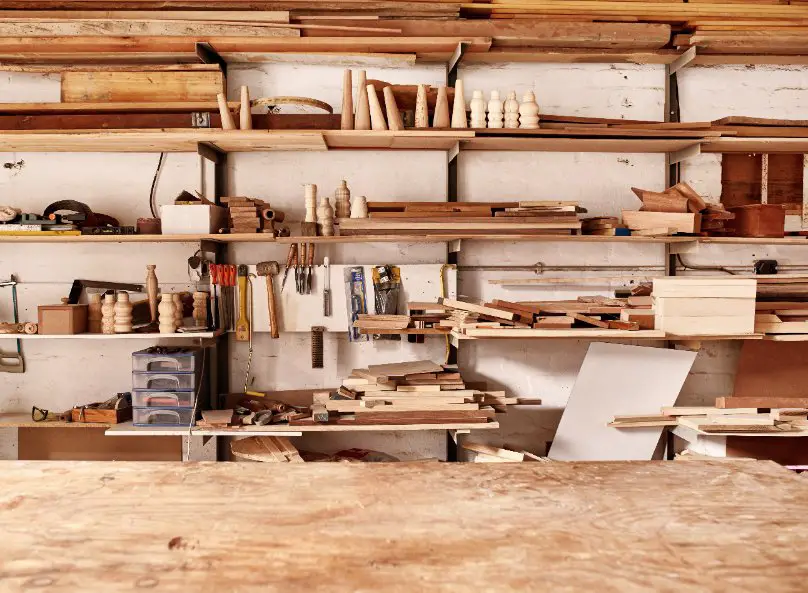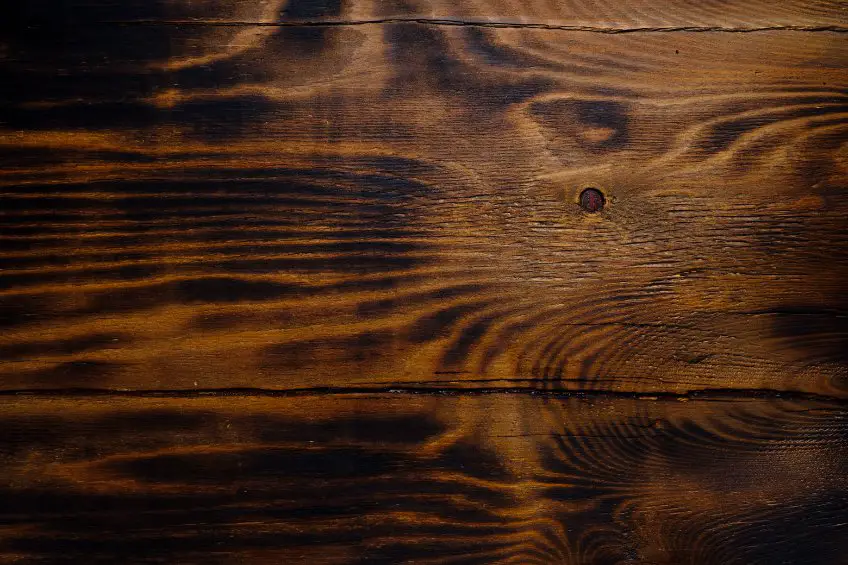Do you have a piece of charred wood that you are wondering if you can seal or not? Are you wanting to know the steps of how to seal charred wood, but not sure where to start? This article can help you understand how to seal charred wood as well as take note of some helpful tips to follow during the process.
The best way to seal charred wood is to brush down the wood, stain it, then seal the stained wood with sealant. Using a test patch, having a light hand, working in a well-ventilated area, and using application techniques, will make it easier to seal the charred wood.
Keep reading to learn more about how to seal charred wood!
Materials You Will Need
You will want to make sure you have gathered all the materials that you need in order to seal the charred wood. These materials include 2-3 brushes varying in size according to your preference, as well as the stain you would like to use on the charred wood, and of course, the sealant. It is important to read the label on both the stain and sealant containers to make sure you have enough for the amount of wood you are planning on staining and sealing.
It is also important to note that you may want to get a few different brushes in different sizes to know which ones will be most comfortable for your hand and that would be the best for the grain and shape of your wood. This will allow you to get every inch of the piece of wood stained and sealed with no patches or crevices you may have missed.
Just like any staining or sealing job, you will want to have wet rags available and close by as you are staining and sealing in order to control the liquid so it doesn’t run all over the wood, creating a mess on the wood that looks bad and not a smooth, seamless stain. You should already be in clothing that you don’t mind getting dirty during this process but if you are wanting to be extra careful, gloves and an apron would be a good idea to wear as you stain and seal the wood. (Source)
Step 1: Brush Down the Wood

To start this process, you will want to brush down your wood. You will want to do this with a dry brush that has not been put in either water or the stain yet. You can use whatever size of brush you want for this, but it would be smart to take a smaller, paintbrush-sized brush to make sure you get in all of the nooks and crannies of the grain of the wood, especially if there are big knots in the piece of wood.
You will want to use a light hand while doing this, making sure to not apply too much pressure with the brush, but enough to remove any dust, sawdust, and any other debris that may make for anything other than a smooth application of both the stain and the sealant.
The order of this step is imperative. You cannot skip this step, nor postpone it to a later time in the process. Brushing this wood prepares the surface of the wood for the stain and the sealant to not only be applied in a smooth stroke but to also avoid any bubbles or buildup of either stain or sealant. This will help make the appearance of the wood look more professional and appealing to the eye, rather than have a tacky, tasteless finish to it. (Source)
Step 2: Stain The Wood
This step can be skipped if you are already happy with the color of the wood. If you would like the color of the wood to be a little lighter or a little darker, then staining is a great option to get the wood to the color you desire for the finished product. As an alternative to staining, you could also use paint.
A stain is a great option if you would still like the grain of the wood to be visible through the lighter or darker color you put on, but if you are wanting the piece to be a solid color all around and have little visibility of the grain, paint is probably what you are looking for as opposed to a stain.
Depending on what stain you purchase and plan to use, follow the directions on the back of the can to prep the stain. This usually includes shaking and mixing the stain well so there is no separation in the container when you open it.
The choice of what size of the brush to use is up to you, but it is a similar technique as the one you used when brushing the wood: use a bigger, wider brush for the majority of the space on the wood, and use a smaller, fine brush for small areas you may miss with the bigger brush. This will ensure you get every inch of the piece stained for a cohesive, finished product. (Source)
Step 3: Seal The Stained Wood
Unlike the many layers of stain that you can coat the piece of wood in, you will want to be stingy on the amount of sealant you put on the brush to place on the wood. Before you start putting on the sealant, allow the stain to dry completely. Also, make sure you are using a clean brush and not the same one you used to apply the stain.
You will want to take off any excess sealant dripping off the brush by scraping it gently on the side of the container. Then, gently place the brush on the wood and begin applying the sealant. Be sure to move the brush in long, straight movements for an even, uniform look throughout.
You will want to make sure each layer of sealant is the same thickness all the way around the wood. This will ensure that the piece of wood will wear evenly, rather than having the end that had a thinner layer of sealant applied to wear down faster than the other.
You can add multiple layers of sealant on top of one another, but make sure the prior layer of sealant is completely dry before applying the next layer. While the sealant is drying, make sure the wood is in a place where debris or dust could land on it. The longer it dries, the more effective the sealant will be long-term. (Source)
Helpful Tip 1: Test Patch
Some sealants work better on some types and grains of wood than others. While it is helpful to read the label of the sealant before purchasing, it is often more helpful to purchase your best option and then do a small test patch on the piece of wood to see if the wood takes the sealant well or if you may need to find a different sealant that would adhere to that specific type of wood better. This can help prevent you from using a whole bucket of expensive sealant that isn’t going to do you any good.
If you are sealing a piece of wood that is going to live outside, a popular sealant choice is one that is polyurethane-based. This base is often mixed with either oil or water and you will want to make sure you choose the water option because that one has a better reputation for upholding in harsh weather conditions.
If you are sealing a piece that is going to stay indoors, a shellac sealant is the most highly recommended option. Polyurethane has toxins in it that are not good nor safe for you to breathe in, making it unsafe to use on projects that will be indoors. Shellac is the better option for indoor projects, but note that if you try and use a shellac-based sealant on an outdoor project, it will not hold up as long as the polyurethane sealant would.
Choosing the right sealant can also make all the difference in how long your finished piece will last before you will have to reapply a layer of sealant. Charred wood without a sealant typically lasts 5 years before it starts to go bad, but with a good sealant, you can go anywhere from 10-15 years before you will need to add another coat of sealant. (Source)
Helpful Tip 2: Use A Light Hand

As was previously mentioned in regards to staining the wood, you will want to use a light hand when applying the sealant just as you did the stain. Most sealants, if you use too much of them, can warp the color of the wood, especially if you have already put in the work to add a particular stain color to it. By using a light hand and doing it one layer at a time, you can better gauge when to stop if you feel the sealant is beginning to change the color of the stain or the original color of the wood.
The purpose of a sealant is to add an extra layer of protection to the original wood. That being said, you can add as many layers of a sealant as you would like, but whether you apply 2 layers or 10 layers, it won’t increase or decrease the effectiveness of the sealant.
Using a light hand also can help you avoid any build-up of globs of sealant, allowing the sealant to appear smooth throughout the entire piece of wood. A thin layer of good quality sealant over the entire area of the piece of wood will do a sufficient job, so don’t feel pressured to apply multiple layers of sealant for it to be effective. (Source)
Helpful Tip 3: Work In A Well-Ventilated Space
While it is encouraged for safety purposes to use stains in a well-ventilated area, especially polyurethane-based stains, all stains should be used and applied in an area that has good ventilation. The chemicals in stains can be extremely harmful if not used properly or in a correctly prepared environment.
When purchasing sealant, look for ingredients that include acetoxy, which is a chemical that has an especially chemical-like smell to it. Inhaling too much of this for a significant amount of time can cause symptoms like lightheadedness and dizziness.
Even if you are using a sealant that is safe for indoors and is being applied to a piece of wood that will stay indoors when finished, it is still important to have consistent airflow to move fresh air through and avoid having you breathe in stagnant, harmful chemicals. Once the wood is dry and sealed, the sealant on the piece is no longer active and is safe to have in your home and in the air, you are breathing, but until then, make sure you have plenty of ventilation while working. (Source)
Helpful Tip 4: Application Patterns
If you have stained or sealed a piece of wood, or have done both before, then you probably already know the basics of how to apply both of them in a way that will get you the smooth, seamless finish you are wanting. If you didn’t know, there is a technique to how you apply both stain and sealant.
If you take either stain or sealant to a piece of wood and brushed it on without any order to it, you may be displeased with the uneven finished product you would receive. Taking the time to apply the stain and the sealant properly is key to getting the end result you want.
To begin, you will want to start at the center of the piece of wood. Move slowly in long, even strokes toward the edges of the piece until the entire piece has been either stained or sealed. Having the center as the starting point helps the look of the stain be a little more forgiving, as the natural color tends to be darker in the center rather than on the edges. (Source)
Do not start on another layer until the first one has dried completely. If you try and add another layer too soon, it can move the wet stain or sealant around, creating an uneven layer both in color and thickness.

